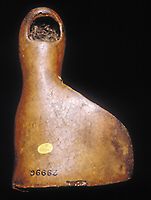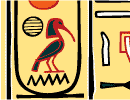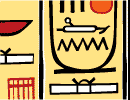|
An Artificial Toe
EgyptRevealed.com -- Early Prosthesis Kept
an Egyptian Looking Good in Sandals
|

British Museum |
One of the earliest examples
of a prothesis.
| You are walking down the street in Thebes,
Egypt, 2,600 years ago, when a cart runs over your foot. The bad news is
you lose a toe. The good news is Egyptian doctors have learned how to make
you another one.
An artificial toe discovered in the dusty archives of the British
Museum and put through a series of tests turns out to be one of the
earliest examples of a prosthesis known anywhere in the world. The
lifelike toe was made of cartonnage, a plaster-treated linen used for
low-cost burials in ancient Egypt, and has a fleshlike color and leathery
texture. Originally it came complete with a toenail that was probably made
of a glassy substance.
The toe is thought to have been used in life before being buried with
its owner. The joint between the artificial toe and the owner's foot would
have been concealed by the strap of a Y-thong sandal, while holes around
the edges suggest it was held in place by laces around the foot.
No one knows to whom the toe belonged, or where he - or she - was
buried. Dolomite limestone and magnesia clay found on the toe indicate it
was made in or near Thebes, close to the Valley of the Kings. The linen in
the cartonnage was woven from a type of yarn found in Egypt no later than
600 B.C. The toe may be several centuries older than that, but its exact
age is uncertain.
In later centuries, Egyptian prosthetics became more elaborate and
commonplace. An artificial forearm, for example, can be found on a mummy
in Arlington Museum, England, while a mummy in The Manchester Museum,
England, boasts a synthetic penis and feet.
SD
|





